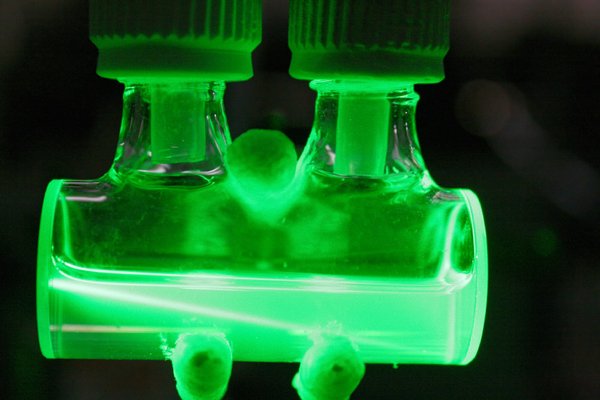Surface of the oceans affects climate more than thought
Leipzig,
30.09.2015
first detected abiotic source of isoprene
Lyon/ Leipzig. The oceans seem to produce significantly more isoprene, and consequently affect stronger the climate than previously thought. This emerges from a study by the Institute of Catalysis and Environment in Lyon (IRCELYON, CNRS / University Lyon 1) and the Leibniz Institute for Tropospheric Research (TROPOS), which had studied samples of the surface film in the laboratory. The results underline the global significance of the chemical processes at the border between ocean and atmosphere, write the researchers in the journal Environmental Science & Technology.
Isoprene is a gas that is formed by both the vegetation and the oceans. It is very important for the climate because this gas can form particles that can become clouds and then later affect temperature and precipitation. Previously it was assumed that isoprene is primarily caused by biological processes from plankton in the sea water. The atmospheric chemists from France and Germany, however, could now show that isoprene could also be formed without biological sources in surface film of the oceans by sunlight and so explain the large discrepancy between field measurements and models. The new identified photochemical reaction is therefore important to improve the climate models.
The oceans not only take up heat and carbon dioxide from the atmosphere, they are also sources of various gaseous compounds, thereby affecting the global climate. A key role is played by the so-called surface microlayer (SML), especially at low wind speed. In these few micrometers thin layer different organic substances such as dissolved organic matter, fat and amino acids, proteins, lipids are accumulating as well as trace metals, dust and microorganisms.
For the now published study, the research team took samples from the Norther Atlantic Ocean. The surface film was collected in the Raunefjord near Bergen in Norway. For this purpose, a glass plate is immersed in water and then again carefully pulled from the water. The 200 micron thin film sticks to the glass and is then scraped off with a wiper. The sample thus obtained is analyzed in the laboratory later. At the Institute of Catalysis and Environment in Lyon (IRCELYON), which belongs to the French research organization CNRS and the University of Lyon 1, the team investigated its photochemical properties during which collected samples were irradiated with light and the gases were analyzed: it became clear that isoprene was produced in magtnetudes that were previously attributed solely to plankton. "We were able for the first time trace back the production of this important aerosol precursor to abiotic sources, so far global calculations consider only biological sources," explains Dr. Christian George from IRCELYON.
Thus, it is now possible to estimate more closely the total amounts of isoprene, which are emitted. So far, however, local measurements indicated levels of about 0.3 megatonnes per year, global simulations of around 1.9 megatons per year. But the team of Lyon and Leipzig estimates that the newly discovered photochemical pathway alone contribute 0.2 to 3.5 megatons per year additionally and could explain the recent disagreements. "The existence of the organic films at the ocean surface due to biological activities therefore influences the exchange processes between air and sea in a unexpected strong way. The photochemical processes at this interface could be a very significant source of isoprene", summarizes Prof. Hartmut Herrmann from TROPOS.
The processes at the boundary between water and air are currently of great interest in science: In August, the team from the CNRS and TROPOS presented evidence in Scientific Reports, the open-access journal of Nature, that dissolved organic material in the surface film is strengthening the chemical conversion of saturated fatty acids into unsaturated gas phase products under the influence of sunlight. For the first time it was realized that these products have to be of biological origin not only, but also abiotic processes at the interface between two media have the potential to produce such molecules. In early September another team from Canada, the US, Great Britain and Germany showed in the journal Nature that organic material from the surface film of the oceans can be an important source for the formation of ice in clouds over remote regions of the North Atlantic, North Pacific and Southern Ocean. The recent publication of the teams from CNRS and TROPOS in Environmental Science & Technology provides indications how the climate models in the important details of the influence of isoprene could be improved. Because of the great importance this paper will be open access as "Editor's Choice". Tilo Arnhold
Publications:
Raluca Ciuraru, Ludovic Fine, Manuela van Pinxteren, Barbara D'Anna, Hartmut Herrmann, and Christian George (2015): Unravelling new processes at interfaces: photochemical isoprene production at the sea surface. Environmental Science & Technology. Just Accepted Manuscript DOI: 10.1021/acs.est.5b02388 <link typo3 acs.est.5b02388 http: dx.doi.org>dx.doi.org/10.1021/acs.est.5b02388
The study was funded by the European Research Council ERC (ERC Grant Agreement 290852 - Airsea).
Raluca Ciuraru, Ludovic Fine, Manuela van Pinxteren, Barbara D’Anna, Hartmut Herrmann & Christian George (2015): Photosensitized production of functionalized and unsaturated organic compounds at the air-sea interface. Scientific Reports, 5:12741, DOI: 10.1038/srep12741 <link typo3 srep12741 http: dx.doi.org>dx.doi.org/10.1038/srep12741
The study was funded by the European Research Council ERC (ERC Grant Agreement 290852 - Airsea).
Further Information:
Dr. Christian George (en. + fr.), Institut de Recherches sur la Catalyse et l'Environnement de Lyon (IRCELYON), Tel: +33-(0)472 44 54 92 http://www.ircelyon.univ-lyon1.fr/syrcel/card/CGO
and
Prof. Dr. Hartmut Herrmann, Dr. Manuela van Pinxteren, Leibniz Institute for Tropospheric Research (TROPOS), Tel. +49-341-2717-7024, -7102 http://www.tropos.de/en/institute/about-us/employees/hartmut-herrmann/ http://www.tropos.de/en/institute/about-us/employees/manuela-van-pinxteren/
or
Tilo Arnhold, public relation of TROPOS , Tel. +49-341-2717-7189 http://www.tropos.de/en/current-issues/press-releases/
Links:
Climat : l’impact des réactions à la surface des océans sur l’atmosphère (press release of CNRS in French) http://www.cnrs.fr/inc/communication/direct_labos/george4.htm
METEOR expedition „BioChemUpwell“ takes a close look at upwelling zones in the Baltic Sea (Press release of 23rd Juli 2015) http://www.tropos.de/en/current-issues/press-releases/details/meteor-expedition-biochemupwell-takes-a-close-look-at-upwelling/
Sea-surface microlayer http://www.io-warnemuende.de/bio-ag-molbio-surface-microlayer.html




